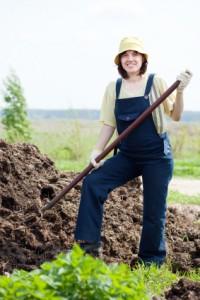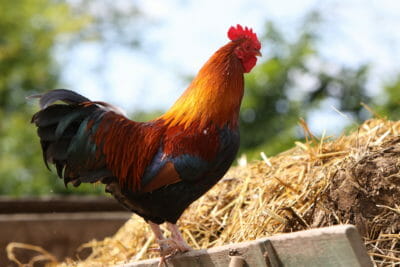As a vegetable gardener, you know that the quality of your soil can make or break your harvest. Vegetables need loose, light, fertile ground that holds water well without becoming sodden. Few gardeners are blessed with this soil, known as loam, occurring naturally in their garden. But with patience and a little help, you can slowly build loam soil. The regular addition of organic matter, found in manure and compost, is one of the best ways to make that ideal garden soil. However, which manures are best? All animal manure improve soil texture and drainage, but some have a higher nutrient content than others. Here we provide a roundup of the best manures for your vegetable garden.
Nutrient Content Of Animal Manure
When it comes to the nutrient content of animal manure, rabbit and chicken manures top the list. These two manures are considerably higher in every nutrient than other livestock animal manures. For example, chicken manure contains 1.8 percent nitrogen, 2.7 percent phosphorus, and 1.5 percent potassium. Rabbit manure consists of 2.4 percent nitrogen, 1.4 percent phosphorus, and 0.6 percent potassium.
In contrast, cow manure, the most commonly used manure, contains 0.5 percent nitrogen, 0.2 percent phosphorus and 0.4 percent potassium. Horse manure has similar values. Swine manure has the lowest nutrient quality, while sheep and alpaca manure fall between chicken and cow manure.
In addition to its high nutrient content, another benefit of chicken manure is its availability. You might not have the acreage to house larger livestock animals, but even urban homesteaders can keep a few chickens, ensuring that you’ll have not only a steady supply of eggs but also a regular stock of free fertilizer.
Weed Content
Another thing to consider is the potential for weed seed in manures. Animals that eat hay also ingest a lot of weed seeds, which survive the digestion process. Composting kills most of these weed seeds, but if you use raw manure in your garden, you might unwittingly increase your weeding chores. Horse manure, in particular, is notorious for carrying weed seeds.
Burn Factor
Raw animal manure contains fresh organic matter, which is very high in nitrogen. This high nitrogen content can burn or damage plants. Chicken manure is the “hottest” manure, followed by cow and horse manure. Rabbits and alpacas have very efficient digestive systems, and people commonly refer to their manures as “cold manures.” This term means that they can be applied raw to the garden with no fear of damaging plants.
Processing Methods

When it comes to the nutrient content of animal manure, rabbit and chicken manures top the list.
How manure is handled and processed can also determine its quality. Manures that contain a lot of bedding material have fewer nutrients. Manures that have sat around in a feedlot for months on end also lose some of their quality.
Dry commercial manures typically have higher nutrient values than some fresh manure, according to Cornell University. For example, dried, commercial cow manure has more than four times as much nitrogen as raw cow manure.
New Natural Fertilizer Doubles Garden Production! [2]
Pathogens
All types of manure have the potential to carry pathogens that can make humans sick. For this reason, you should either use manure that’s been thoroughly composted, or use the 90/120 day rule. When applying uncomposted manure to the garden (and this includes rotted manure), apply manure to tall crops that don’t touch the soil, such as corn and staked tomatoes. In addition, do this ninety days before the expected harvest. Spread uncomposted manure for ground crops, such as watermelon, root vegetables, and leafy vegetables, at least 120 days before harvest.
Many people dig manure into the vegetable garden in the fall, which has several advantages. First, with this practice, you can use fresh or rotted manure without fear of pathogens. The soil will have time to settle before you start planting, and you’ll eliminate one task from your to-do list the following spring.
Quantity
How much animal manure should you use in your garden? This number depends, in part, on the quality of your soil, the age of your garden, and the crops you grow. It’s always a good idea to get a soil sample analysis done every three to five years. A soil analysis can tell you the nutrients your soil lacks, as well as the nutrients your soil has in abundance. My Colorado soil, for example, is always lacking in nitrogen but has plenty of phosphorus. I’m careful not to add a lot of phosphorus in the form of synthetic fertilizers because too many nutrients can be as detrimental as too little. Excess phosphorus in the soil can pollute waterways and streams, choking out aquatic life.
In general, gardeners can safely add two to four inches of manure to a newly established garden. After that, one to two inches of manure or compost is a reasonable amount to maintain soil fertility and texture. For larger gardens, it might be easier to calculate manure usage in pounds. The University of Alaska [3] recommends using no more than 550 pounds of manure for a 1,000 square-foot plot.
Hungry plants like corn or watermelon might need a bit more. Root vegetables and leafy vegetables usually need less. You can also use manure as a side dressing throughout the season. Just spread a shovelful of manure around the plants midseason and water it in well.
Should You Use Bat Guano For Animal Manure?
Manure has been used for centuries to maintain soil fertility. It’s free or inexpensive, continuously renewable, and readily available. Although an understanding of the various types of manure is helpful, don’t over think the process.
For example, bat guano has one of the highest nutrient profiles of any animal manure, but how many of us have access to free bat guano? The commercially processed stuff is exorbitantly priced, which effectively eliminates one of the best aspects of using manure—its affordability.
Bat guano isn’t an affordable or practical choice for most gardeners. Instead, use what you have readily available in your area. I currently have neither a truck nor livestock animals. When I first established my vegetable garden, I knew I’d need a lot of manure, and I didn’t want to pay premium prices. So, I borrowed a truck from a friend and headed to an alpaca farm nearby. The farmer was happy to have me take his manure, and I was glad to get it at no charge.
Final Animal Manure Recommendations
Now, most of the time, I buy a few bags of manure from my local garden center. My garden is small enough that ten bags usually does the trick. In the future, I hope to have a chicken coop, which will supply me with plenty of manure. In the meantime, I try to keep things as simple and affordable as possible.
Use composted animal manure whenever possible. If you get manure from a farmer or your own livestock, you can compost it quickly in a large compost bin. Remember, manure counts as a green material unless it’s mixed with a lot of bedding material.
If you opt for raw or rotted manure, make sure that you spread it during cool weather when it smells less. Till it into the soil at least two months before you plant anything. A mulch of straw or untreated grass clippings can help with any weed seeds that inadvertently make their way into your garden via the manure.
For additional reading, check out Double Your Survival Garden Production By Adding Key Nutrients [4].
What do you think about the benefits of using animal manure in your garden? Let us know in the comments below.
